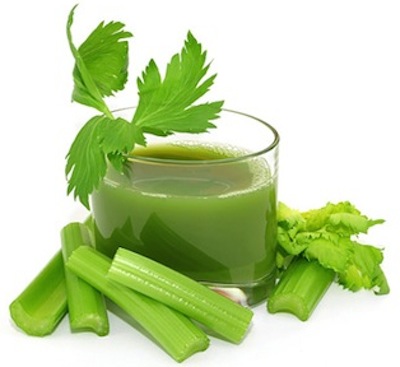Celery – A Medicinal Food for Everything from Heart to Bone
“Let food be thy medicine and medicine be thy food.” That is what Hippocrates used to say, probably having more than a few medicinal foods in mind. And while we will never know exactly which foods made it to Hippocrates list, we can say without any doubt that celery must have been among the most valued, especially if we take into account the numerous scientific studies that have confirmed its traditional uses.

Contents
Uses confirmed by scientific studies
- High blood pressure (A study on rats, published in Journal of Medicinal Food in 2013, concluded that “celery seed extracts have antihypertensive properties, which appears to be attributable to the actions of its active hydrophobic constitutes such as n-butylphthalide and can be considered as an antihypertensive agent in chronic treatment of elevated blood pressure.” And what is equally important is the fact that the celery extract had no effect on normotensive rats.)
- High levels of cholesterol and triglycerides (A study published in Pharmacognosy Magazine in 2009 showed that celery seed extract had the effect of lowering the levels of cholesterol and triglygerides by 27% and 22%, respectively.)
- Cancer (A study published in Asian Pacific Journal of Cancer Prevention in 2011 showed that celery seed extract had an antiproliferative effect on a type of human gastric cancer. A previous study, published in Nutrition and Cancer in 1993, had shown that three substances found in celery – p-mentha-2,8-dien-1-ol, 3-n-butyl phthalide and sedanolide – can increase 4-5 times the activity of glutathione S-transferase, a cytoprotective enzyme which is essential for the deactivation of potential carcinogens.)
- Diabetes (A study published in Diabetes Care in 2010 revealed that a higher intake of vitamin K is associated with a decrease of up to 20% of the risk for type II diabetes. Celery has a high content of vitamin K and it is also efficient against Helicobacter pylori, which is known to triple the risk of type II diabetes. Moreover, the high content of dietary fibers – cellulose – in celery slows down the intestinal absorption of carbohydrates and prevents a critical peak of blood glucose level, thus protecting the pancreas.)
- Dismenorrhea (A study published in Iranian Journal of Pharmaceutical Research in 2004 demonstrated that a herbal remedy made from saffron, annise and celery seed extracts was three times better than placebo and similar to mefenemic acid in decreasing the intensity of the pain.)
- Gastric ulcer (A study published in Natural Product Research in 2013 proved that a celery extract had an inhibitory effect on gastric lesions similar to that of omeprazole and, moreover, the celery essential oil was “strongly inhibitory against Escherichia coli and moderately inhibitory against Pseudomonas aeruginosa and Staphylococcus aureus.” Previously, a study published in Journal of Pharmacology and Pharmacotherapeutics in 2009 found that a compound from celery seed has a bactericidal effect against Helicobacter pylori.)
- Fungal infections (Results of a study published in Natural Product Research in 2013 showed the presence of sedanenolide, neocnidilide and especially neophytadiene to be responsible for a clinically significant antifungal activity against Candida (several species), Trychophyton (several species), Criptococcus, Microsporum (several species), Epidermophyton and Aspergillus (several species).
- Rheumatism (In a study published in Planta Medica in 2007, researchers found that “luteolin may be a potent selective inhibitor of cyclooxygenase-2 (COX-2) and that the inhibition is attributable to its down-regulation of the mRNA expression of COX-2 in inflammatory responses.” The same substance seems to be capable of reducing age-related inflammation in the brain and the related memory problems.)
- Gout (Gout is characterized by elevated levels of uric acid. A study published in Polish Journal of Food and Nutrition Sciences showed that a celery seed extract reduced the levels of uric acid by 56%.)
- Obesity (Studying the “biological and nutritional impact of celery and turnip leaves on induced obese by high fat diet”, researchers discovered that “the rats feeding on high fat diet with fresh blanch celery had the lowest weight of total adipose tissue mass”. The study was published in Journal of Food and Nutrition Sciences in 2014.)
Other uses
- Demineralization (due to its high content of minerals: potassium – 260-442 mg/100 g, calcium – 40 mg/100 g, phosphorus – 24-74 mg/100 g, sodium – 20-80 mg/100 g, magnesium – 11-14 mg/100 g)
- Heart arrhythmia (due to the high content of potassium and magnesium)
- Insomnia (mostly due to its relatively high content of magnesium)
- Cystitis (due to anti-inflammatory and anti-infectious properties)
- Renal and gall stones (due to its diuretic properties and its high content of dietary fibers, respectively)
- Chronic bronchitis, tuberculosis, pneumonia (due to the antispasmodic effects of d-limonene, selinene and related phthalides)
- Infertility, premature menopause (due to the presence of certain phytohormones that have a regulating effect on the pituitary gland, which controls, among others, the activity of the ovaries)
Administration
The usual daily dose is 50-150 ml of celery juice, 50-100 g of celery root in salads, or 5 g of seeds powder.
Precautions
Celery is contraindicated during pregnancy (it can stimulate uterine contractions and thus cause a miscarriage) and breast-feeding and also two weeks before surgery (it exaggerates the effect of anesthesia on the central nervous system).
If consumed for extended periods, celery may cause photodermatitis. Therefore, it is strongly recommended the use of sunscreen lotions. Also, it is to be used with precaution by those suffering from kidney disease (because it may cause or exacerbate an inflammation) or low blood pressure.




Wow I didn’t think it was that good for you. Guess I’ll keep eating it thanks